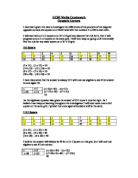Number Grid – Opposite Corners Investigation
Introduction:
This task involves pupils investigating the relationship between the results, when diagonally opposite numbers in various sizes of squares are multiplied, and comparing the products.
Number Grid – Opposite Corners Investigation
Method:
- I will use a number grid from 1-100, like the one below, to collect examples of data from different size squares.
- I will show 4 examples of each size of squares, to confirm each of the differences at the different stages.
- I will look for a pattern and, if I find one, will explain it fully.
- I will make a prediction of what I think will happen next and see if it works.
- I will create an algebraic expression to prove my results.
- I will then test my algebraic expression on the diagonally opposite corners a rectangle, to see if that works as well.
- I will then describe the sequence and relationship of the results.
- I will present my results in a table and write a conclusion.
Prediction:
I predict that there will be a relevant relationship between the size of the box and the difference in results of the opposite corners. I think there will be a pattern, and an algebraic expression, which will work for all the box sizes. I think this investigation will be one in which you could branch off into many different sections. I think there will be a lot to explore and a lot to think about. Overall, I think this will be a challenging, but thought-provoking investigation and I think I will enjoy discovering the results.

This is a preview of the whole essay
Teacher Reviews
Here's what a teacher thought of this essay
There is some good investigative work carried out here. However the mathematical content is fairly limited. Generally there should be some evidence of not only the calculation of an nth term but also the multiplication of double brackets. For example (x + 5)(x - 2).








